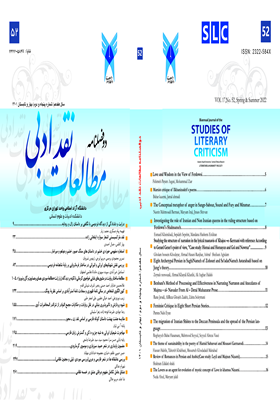Conceptual metaphor of anger in Sange-Sabour, Sound and Fury and Miramar
Subject Areas : مطالعات نقد ادبی
nasrin Mahmoudi Barmasi
1
![]() ,
maryam Iraji
2
*
,
maryam Iraji
2
*
![]() ,
Jinuss Shirvan
3
,
Jinuss Shirvan
3
1 - Phd candidate of Linguistics, Islamic Azad University, Tehran center Branch, Tehran, Iran.
2 - Assistant Professor, Department of Linguistics, Islamic Azad University, Central Tehran Branch, Tehran, Iran.
3 - Assistant Professor, Department of Linguistics, Islamic Azad University, Central Tehran Branch, Tehran, Iran.
Keywords: Persian, English, conceptual metaphor, Arabic, Generic level metaphor, Angry,
Abstract :
This article is a descriptive-analytical research based on conceptual metaphor theory (CMT), which studies the conceptual metaphors of the field of anger in three fictional works of Sange Sabour (Persian), Sound and Fury (English) and Miramar (Arabic). The findings of the research show that one of the most frequent source domains that all three authors have used to express the abstract concept of anger is the specific metaphor "ANGER IS AN OBJECT / TOOL". Of course, just by having one common source domain, it is not possible to strongly emphasize the universality of conceptual metaphors, and the existing differences indicate culture-specificity of these specific metaphors.But in relation to Generic- level metaphors in these stories, it was found that all three writers, Sadegh Chubak, William Faulkner, and Najib Mahfouz, have benefited the most from the Generic- level metaphor "EMOTIONS ARE OBJECT" in the field of anger, and it can be said that at the Generic- level of metaphors, The universality of metaphors can be confirmed.
ابراهیمی، ب. عامری، ح. ابوالحسنی چیمه، ز.(1398). تحلیلی استعاری زبانشناختی بر ضربالمثلهای حوزۀ احساسی خشم در زبان های فارسی و ترکی، فصلنامۀ ادبیات و زبان های محلی ایران زمین. 9(3).34-17
چوبک، صادق.(1369). سنگ صبور، چاپ جدید، شرکت کتاب، لوس آنجلس :1369 براساس چاپ اول ، تهران، 1345 .
خداپرستی، فرج الله.(1376). فرهنگ جامع مترادف و متضاد زبان فارسی، دانشنامهی فارس: شیراز.
روحی، م. روشن، ب. راسخ مهند، م.(1397). بررسی استعاره های خشم در زبان های فارسی، کردی و گیلکی در چهارچوب شناختی، زبان فارسی و گویش های ایرانی، سال سوم. (5)1. 56-31
طبیبیان. س.ح.(1387). فرهنگ فرزان فارسی ـ عربی، فرزان، تهران.
فاکنر، ویلیام.(1397). خشم و هیاهو، ترجمهی صالح حسینی، چاپ دوازدهم، تهران، انتشارات نیلوفر.
محفوظ، نجیب.(2007). میرامار، قاهره، دارالشروق.
Ansah, Gladys Nyarko. (2014). Culture in embodied cognition: Metaphorical/metonymic conceptualizations of FEAR in Akan and English. Metaphor and Symbol, 29 (1): 44-58.
Crisp, P., Gibbs, R., Deignan, A., Low, G., Steen, G., Cameron, L., Semino, E., Grady, J., Cienki, A., & Kövecses, Z. (The Pragglejaz Group). (2007). MIP: A method for identifying metaphorically used words in discourse. Metaphor and Symbol, 22(1), 1–39.
Geeraerts, D. & Grondelaers, S. (1995). Looking Back at Anger: Cultural Traditions and Metaphorical Patterns. In: J. Taylor and R. MacLaury (ed.), Language and the Cognitive Construal of the World. Berlin: Mouton de Gruyter, 153-179.
Kövecses, Z. (1986) Metaphors of Anger, Pride, and Love: A Lexical Approach to the Structure of Concepts. Amsterdam-Philadelphia: John Benjamins.
Kövecses, Z. (1990). Emotion concepts. Berlin and New York: Springer-Verlag. http://dx.doi.org/10.1007/978-1-4612-3312-1
Kövecses, Z. (2003). Metaphor and linguistic expressions. In Z. Kovecses (2005) Metaphor in Culture Universality and Variation (pp. 130-140). Cambridge׃ Cambridge University Press.
Kövecses, Z. (2006) Embodiment, Experiential Focus, and Diachronic Change in Metaphor. Paper presented at the 2005 Symposium on New Approaches in English Historical Lexis. In: R.W. McConchie, O. Timofeeva, H. Tissari & T. Säily (eds.), Selected Proceedings of the 2005 Symposium on New Approaches in English Historical Lexis (HEL-LEX). Cascadilla Proceedings Project, Somerville, MA, USA, 1-7.
Lakoff, G. (1987) Women, Fire and Dangerous Things: What Categories Reveal about the Mind. Chicago: University of Chicago Press.
Matsuki, K. .(1995). Metaphors of anger in Japanese. In J. Taylor & R.E. Maclaury (Eds.), Language and the Cognitive Construal of the World (pp.137-151). Berlin: Mouton de Gruyter.
_||_

